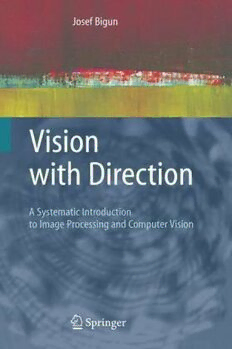Table Of ContentJosefBigun
VisionwithDirection
Josef Bigun
Vision with Direction
ASystematicIntroduction
toImageProcessingandComputerVision
With146Figures,including130inColor
123
JosefBigun
IDE-Sektionen
Box823
SE-30118,Halmstad
Sweden
[email protected]
www.hh.se/staff/josef
LibraryofCongressControlNumber:2005934891
ACMComputingClassification(1998):I.4,I.5,I.3,I.2.10
ISBN-10 3-540-27322-0 SpringerBerlinHeidelbergNewYork
ISBN-13 978-3-540-27322-6 SpringerBerlinHeidelbergNewYork
Thisworkissubjecttocopyright.Allrightsarereserved,whetherthewholeorpartofthematerial
isconcerned,specificallytherightsoftranslation,reprinting,reuseofillustrations,recitation,broad-
casting,reproductiononmicrofilmorinanyotherway,andstorageindatabanks.Duplicationof
thispublicationorpartsthereofispermittedonlyundertheprovisionsoftheGermanCopyrightLaw
ofSeptember9,1965,initscurrentversion,andpermissionforusemustalwaysbeobtainedfrom
Springer.ViolationsareliableforprosecutionundertheGermanCopyrightLaw.
SpringerisapartofSpringerScience+BusinessMedia
springer.com
©Springer-VerlagBerlinHeidelberg2006
PrintedinGermany
Theuseofgeneraldescriptivenames,registerednames,trademarks,etc.inthispublicationdoesnot
imply,evenintheabsenceofaspecificstatement,thatsuchnamesareexemptfromtherelevantpro-
tectivelawsandregulationsandthereforefreeforgeneraluse.
TypesetbytheauthorusingaSpringerTEXmacropackage
Production:LE-TEXJelonek,Schmidt&VöcklerGbR,Leipzig
Coverdesign:KünkelLopkaWerbeagentur,Heidelberg
Printedonacid-freepaper 45/3142/YL-543210
Tomyparents,H.andS.Bigun
Preface
Imageanalysisisacomputationalfeatwhichhumansshowexcellencein,incompar-
isonwithcomputers.Yetthelistofapplicationsthatrelyonautomaticprocessingof
imageshasbeengrowingatafastpace.Biometricauthenticationbyface,fingerprint,
andiris,onlinecharacterrecognitionincellphonesaswellasdrugdesigntoolsare
butafewofitsbenefactorsappearingontheheadlines.
This is, of course, facilitated by the valuable output of the resarch community
inthepast30years.Thepatternrecognitionandcomputervisioncommunitiesthat
study image analysis have large conferences, which regularly draw 1000 partici-
pants.Inawaythisisnotsurprising,becausemuchofthehuman-specificactivities
critically rely on intelligent use of vision. If routine parts of these activities can be
automated, much is to be gained in comfort and sustainable development. The re-
searchfieldcouldequallybecalled visualintelligencebecauseitconcernsnearlyall
activities of awake humans. Humans use or rely on pictures or pictorial languages
torepresent,analyze,anddevelopabstractmetaphorsrelatedtonearlyeveryaspect
ofthinkingandbehaving,beitscience,mathematics,philosopy,religion,music,or
emotions.
Thepresentvolumeisanintroductorytextbookonsignalanalysisofvisualcom-
putationforsenior-levelundergraduatesorforgraduatestudentsinscienceanden-
gineering. My modest goal has been to present the frequently used techniques to
analyzeimagesinacommonframework–directionalimageprocessing.Inthat,Iam
certainlyinfluencedbythemassiveevidenceofintricatedirectionalsignalprocess-
ingbeingaccumulatedonhumanvision.Myhopeisthatthecontentsofthepresent
text will be useful to a broad category of knowledge workers, not only those who
are technically oriented. To understand and reveal the secrets of, in my view, the
mostadvancedsignalanalysis“system”oftheknownuniverse,primatevision,isa
greatchallenge.Itwillpredictablyrequirecross-fieldfertilizationsofmanysortsin
science,nottheleastamongcomputervision,neurobiology,andpsychology.
Thebookhasfiveparts,whichcanbestudiedfairlyindependently.Thesestud-
ies are most comfortable if the reader has the equivalent mathematical knowledge
acquired during the first years of engineering studies. Otherwise, the lemmas and
theorems can be read to acquire a quick overview, even with a weaker theoretical
VIII Preface
background. Part I presents briefly a current account of the human vision system
with short notes to its parallels in computer vision. Part II treats the theory of lin-
ear systems, including the various versions of Fourier transform, with illustrations
from image signals. Part III treats single direction in images, including the ten-
sor theory for direction representation and estimation. Generalized beyond Carte-
sian coordinates, an abstraction of the direction concept to other coordinates is of-
fered.Here,thereadermeetsanimportanttoolofcomputervision,theHoughtrans-
form and its generalized version, in a novel presentation. Part IV presents the con-
cept of group direction, which models increased shape complexities. Finally, Part
V presents the grouping tools that can be used in conjunction with directional pro-
cessing.Theseincludeclustering,featuredimensionreduction,boundaryestimation,
andelementarymorphologicaloperations.Informationondownloadablelaboratory
exercises(inMatlab)basedonthisbookisavailableatthehomepageoftheauthor
(http://www.hh.se/staff/josef).
Iamindebtedtoseveralpeoplefortheirwisdomandthehelpthattheygaveme
whileIwaswritingthisbook,andbefore.Icameincontactwithimageanalysisby
readingthepublicationsofProf.Go¨staH.Granlund ashisPhDstudentandduring
thebeautifuldiscussionsinhisresearchgroupatLinko¨pingUniversity,nottheleast
withProf.HansKnutsson,inthemid-1980s.Thisheritageisunmistakenlyrecogniz-
ableinmytext.Inthe1990s,duringmyemploymentattheSwissFederalInstitute
of Technology in Lausanne, I greatly enjoyed working with Prof. Hans du Buf on
textures.Thetracesofthiscollaborationaredistinctlyvisibleinthevolume,too.
I have abundantly learned from my former and present PhD students, some of
theirworkanddevotionisnotonlyaliveinmymemoryanddailywork,butalsoin
thegraphicsandcontentsofthisvolume.Iwishtomention,alphabetically,Yaregal
Assabie,SergeAyer,BenoitDuc,MaycelFaraj,StefanFischer,HartwigFronthaler,
OleHansen,KlausKollreider,KennethNilsson,MartinPersson,LalithPremaratne,
PhilippeSchroeter,andFabrizioSmeraldi.Asteachersintwoimageanalysiscourses
using drafts of this volume, Kenneth, Martin, and Fabrizio provided, additionally,
importantfeedbackfromstudents.
I was privileged to have other coworkers and students who have helped me out
alongthe“voyage”thatwritingabookis.Iwishtonamethosewhosecontributions
have been most apparent, alphabetically, Markus Bc¨kman, Kwok-wai Choy, Stefan
Karlsson, Nadeem Khan, Iivari Kunttu, Robert Lamprecht, Leena Lepisto¨, Madis
Listak,HenrikOlsson,WernerPomwenger,BerndResch,PeterRomirer-Maierhofer,
RadakrishnanPoomari,ReneSchirninger,DerkWesemann,HeikeWalter,andNiklas
Zeiner.
Atthefinalportofthisvoyage,Iwishtomentionnottheleastmyfamily,who
notonlyputupwithmewritingabook,ofteninvadingtheprivatesphere,butwho
also filled the breach and encouraged me with appreciated “kicks” that have taken
meoutoflocalminima.
I thank you all for having enjoyed the writing of this book and I hope that the
readerwillenjoyittoo.
August2005 J.Bigun
Contents
PartI HumanandComputerVision
1 NeuronalPathwaysofVision .................................... 3
1.1 OpticsandVisualFieldsoftheEye .......................... 3
1.2 PhotoreceptorsoftheRetina ................................ 5
1.3 GanglionCellsoftheRetinaandReceptiveFields .............. 7
1.4 TheOpticChiasm......................................... 9
1.5 LateralGeniculateNucleus(LGN) ........................... 10
1.6 ThePrimaryVisualCortex.................................. 11
1.7 SpatialDirection,Velocity,andFrequencyPreference........... 13
1.8 FaceRecognitioninHumans................................ 17
1.9 FurtherReading........................................... 19
2 Color ......................................................... 21
2.1 LensandColor ........................................... 21
2.2 RetinaandColor .......................................... 22
2.3 NeuronalOperationsandColor.............................. 24
2.4 The1931CIEChromaticityDiagramandColorimetry .......... 26
2.5 RGB:Red,Green,BlueColorSpace ......................... 30
2.6 HSB:Hue,Saturation,BrightnessColorSpace................. 31
PartII LinearToolsofVision
3 DiscreteImagesandHilbertSpaces .............................. 35
3.1 VectorSpaces ............................................ 35
3.2 DiscreteImageTypes,Examples............................. 37
3.3 NormsofVectorsandDistancesBetweenPoints ............... 40
3.4 ScalarProducts ........................................... 44
3.5 OrthogonalExpansion ..................................... 46
3.6 TensorsasHilbertSpaces................................... 48
3.7 SchwartzInequality,AnglesandSimilarityofImages ........... 53
X Contents
4 ContinuousFunctionsandHilbertSpaces......................... 57
4.1 FunctionsasaVectorSpace................................. 57
4.2 AdditionandScalinginVectorSpacesofFunctions............. 58
4.3 AScalarProductforVectorSpacesofFunctions ............... 59
4.4 Orthogonality............................................. 59
4.5 SchwartzInequalityforFunctions,Angles .................... 60
5 FiniteExtensionorPeriodicFunctions—FourierCoefficients ....... 61
5.1 TheFiniteExtensionFunctionsVersusPeriodicFunctions ....... 61
5.2 FourierCoefficients(FC) ................................... 62
5.3 (Parseval–Plancherel)ConservationoftheScalarProduct........ 65
5.4 HermitianSymmetryoftheFourierCoefficients................ 67
6 FourierTransform—InfiniteExtensionFunctions.................. 69
6.1 TheFourierTransform(FT)................................. 69
6.2 SampledFunctionsandtheFourierTransform ................. 72
6.3 DiscreteFourierTransform(DFT) ........................... 79
6.4 CircularTopologyofDFT .................................. 82
7 PropertiesoftheFourierTransform.............................. 85
7.1 TheDiracDistribution ..................................... 85
7.2 ConservationoftheScalarProduct........................... 88
7.3 Convolution,FT,andtheδ.................................. 90
7.4 ConvolutionwithSeparableFilters........................... 94
7.5 PoissonSummationFormula,theComb ...................... 95
7.6 HermitianSymmetryoftheFT .............................. 98
7.7 CorrespondencesBetweenFC,DFT,andFT................... 99
8 ReconstructionandApproximation .............................. 103
8.1 CharacteristicandInterpolationFunctionsinN Dimensions ..... 103
8.2 SamplingBand-PreservingLinearOperators................... 109
8.3 SamplingBand-EnlargingOperators ......................... 114
9 ScalesandFrequencyChannels.................................. 119
9.1 SpectralEffectsofDown-andUp-Sampling................... 119
9.2 TheGaussianasInterpolator ................................ 125
9.3 OptimizingtheGaussianInterpolator......................... 127
9.4 ExtendingGaussianstoHigherDimensions ................... 130
9.5 GaussianandLaplacianPyramids............................ 134
9.6 DiscreteLocalSpectrum,GaborFilters ....................... 136
9.7 DesignofGaborFiltersonNonregularGrids .................. 142
9.8 FaceRecognitionbyGaborFilters,anApplication.............. 146
Contents XI
PartIII VisionofSingleDirection
10 Directionin2D ................................................ 153
10.1 LinearlySymmetricImages................................. 153
10.2 RealandComplexMomentsin2D........................... 163
10.3 TheStructureTensorin2D ................................. 164
10.4 TheComplexRepresentationoftheStructureTensor............ 168
10.5 LinearSymmetryTensor:DirectionalDominance .............. 171
10.6 BalancedDirectionTensor:DirectionalEquilibrium ............ 171
10.7 DecomposingtheComplexStructureTensor................... 173
10.8 DecomposingtheReal-ValuedStructureTensor ................ 175
10.9 ConventionalCornersandBalancedDirections................. 176
10.10 TheTotalLeastSquaresDirectionandTensors................. 177
10.11 DiscreteStructureTensorbyDirectTensorSampling ........... 180
10.12 ApplicationExamples...................................... 186
10.13 DiscreteStructureTensorbySpectrumSampling(Gabor)........ 187
10.14 RelationshipoftheTwoDiscreteStructureTensors ............. 196
10.15 HoughTransformofLines.................................. 199
10.16 TheStructureTensorandtheHoughTransform ................ 202
10.17 Appendix ................................................ 205
11 DirectioninCurvilinearCoordinates............................. 209
11.1 CurvilinearCoordinatesbyHarmonicFunctions ............... 209
11.2 LieOperatorsandCoordinateTransformations................. 213
11.3 TheGeneralizedStructureTensor(GST)...................... 215
11.4 DiscreteApproximationofGST ............................. 221
11.5 TheGeneralizedHoughTransform(GHT) .................... 224
11.6 VotinginGSTandGHT.................................... 226
11.7 HarmonicMonomials...................................... 228
11.8 “Steerability”ofHarmonicMonomials ....................... 230
11.9 SymmetryDerivativesandGaussians......................... 231
11.10 DiscreteGSTforHarmonicMonomials....................... 233
11.11 ExamplesofGSTApplications.............................. 236
11.12 FurtherReading........................................... 238
11.13 Appendix ................................................ 240
12 DirectioninND,MotionasDirection ............................ 245
12.1 TheDirectionofHyperplanesandtheInertiaTensor ............ 245
12.2 TheDirectionofLinesandtheStructureTensor................ 249
12.3 TheDecompositionoftheStructureTensor.................... 252
12.4 BasicConceptsofImageMotion ............................ 255
12.5 TranslatingLines.......................................... 258
12.6 TranslatingPoints ......................................... 259
12.7 DiscreteStructureTensorbyTensorSamplinginND ........... 263
XII Contents
12.8 AffineMotionbytheStructureTensorin7D................... 267
12.9 MotionEstimationbyDifferentialsinTwoFrames ............. 270
12.10 MotionEstimationbySpatialCorrelation ..................... 272
12.11 FurtherReading........................................... 274
12.12 Appendix ................................................ 275
13 WorldGeometrybyDirectioninN Dimensions ................... 277
13.1 CameraCoordinatesandIntrinsicParameters .................. 277
13.2 WorldCoordinates ........................................ 283
13.3 IntrinsicandExtrinsicMatricesbyCorrespondence............. 287
13.4 Reconstructing3DbyStereo,Triangulation ................... 293
13.5 SearchingforCorrespondingPointsinStereo.................. 300
13.6 TheFundamentalMatrixbyCorrespondence .................. 305
13.7 FurtherReading........................................... 307
13.8 Appendix ................................................ 308
PartIV VisionofMultipleDirections
14 GroupDirectionandN-FoldedSymmetry........................ 311
14.1 GroupDirectionofRepeatingLinePatterns ................... 311
14.2 TestImagesbyLogarithmicSpirals .......................... 314
14.3 GroupDirectionTensorbyComplexMoments................. 315
14.4 GroupDirectionandthePowerSpectrum ..................... 318
14.5 DiscreteGroupDirectionTensorbyTensorSampling ........... 320
14.6 GroupDirectionTensorsasTextureFeatures .................. 324
14.7 FurtherReading........................................... 326
PartV Grouping,Segmentation,andRegionDescription
15 ReducingtheDimensionofFeatures.............................. 329
15.1 PrincipalComponentAnalysis(PCA) ........................ 329
15.2 PCAforRareObservationsinLargeDimensions............... 335
15.3 SingularValueDecomposition(SVD) ........................ 338
16 GroupingandUnsupervisedRegionSegregation................... 341
16.1 TheUncertaintyPrincipleandSegmentation................... 341
16.2 PyramidBuilding ......................................... 344
16.3 ClusteringImageFeatures—PerceptualGrouping .............. 345
16.4 FuzzyC-MeansClusteringAlgorithm ........................ 347
16.5 EstablishingtheSpatialContinuity........................... 348
16.6 BoundaryRefinementbyOrientedButterflyFilters ............. 351
16.7 TextureGroupingandBoundaryEstimationIntegration ......... 354
16.8 FurtherReading........................................... 356

